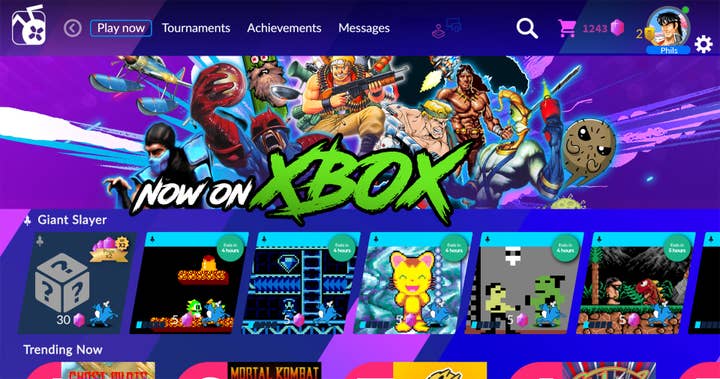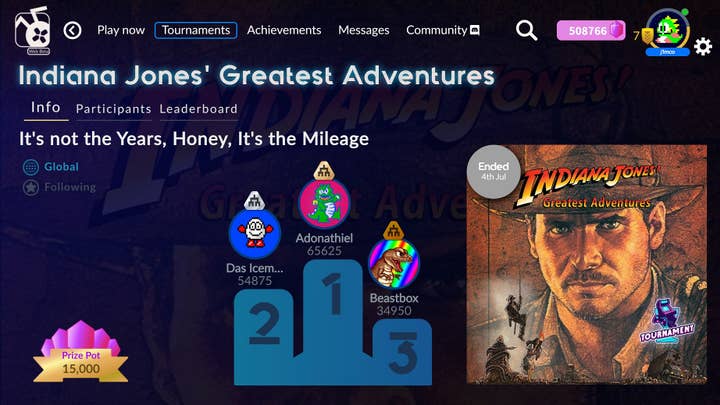Antstream looks to build a future by preserving the past
Retro streaming service CEO Steve Cottam talks about waste, piracy, and offering new takes on old classics
In playing around with the retro game streaming subscription service Antstream Arcade recently, a thought occurred to us.
It is possible to use an Android gaming device to remotely power up an Xbox Series X console on another continent (where it has been left in the power-consuming rest mode), at which point you can then open up the Antstream app and have it connect to remote servers to play an emulated version of Atari 2600's Combat, a game that fits on a 2KB cartridge and could be distributed in its entirety for an infinitesimal fraction of the bandwidth and energy such a streaming set-up would require.
It's a web of interoperability and convenience as impressive as it is wasteful, so we set up a chat with Antstream CEO Steve Cottam to find out a bit more about the service and why things are the way they are.
"I get asked this a lot," Cottam says. "Why are we streaming these tiny games? It's really about accessibility."
He notes two things. First, he says Antstream has an Android native app so that layer of the chain could be omitted entirely (even though Xbox subscribers would need to start a new account and pay for a separate subscription for non-Xbox platforms). Second, he says that while Antstream does have games from systems like the 2600, Commodore 64 and Spectrum that could be downloaded in their entirety as fast as they could be streamed, its collection of 1,500 games for on-demand streaming includes titles up to the PlayStation era, which can take up about 1GB of data.
"We wanted to create a system that's future proof and one where it's consistent," Cottam says. "So it doesn't matter if you're playing a 2600 game or a PlayStation game; you click it and you're in straight away. You haven't got to worry about getting emulators working on all the different devices we support; that's pretty difficult. In some cases you're restricted by store policies that don't let you run emulation. So streaming was a way for us to get retro gaming to everybody on every device."
It wasn't just about consistency; an emulator service that involved downloading the games to a client device probably would not have received the same support from publishers that Antstream has received.
"I think the concerns over emulation historically weren't about emulation per se but the piracy issue that went with it," Cottam says.
"And I won't say that's the reason we did cloud streaming, but it was another benefit. You can't copy the ROMs. The IP holders felt comfortable doing a deal with us because they knew you couldn't just copy the ROMs and give them to your friends.

"Piracy is a mixed bag because obviously piracy is what's kept these games alive for the last 20, 30, 40 years. So the community's done a huge service to the industry keeping them alive, better in some cases than some of the companies themselves.
Piracy is a mixed bag because obviously piracy is what's kept these games alive for the last 20, 30, 40 years
"The flip side of that coin is I've spoken to developers who owned IP and put it on Antstream, and before Antstream, they hadn't earned a penny for it in the last 30 or 40 years yet there's thousands or hundreds of thousands of people playing them a year. That's also not right. Some of them couldn't even afford the train fare to come and see me.
"It's nice to be able to give back to the creators because a lot of these games are not owned by big companies. Many are owned by individual developers who retained the IP."
One of the challenges with running a subscription service is creating a pipeline of new content to drive sign-ups. Netflix can create original shows, and Microsoft can launch Starfield into Game Pass. Antstream's current library may be enough to entice people to sign up, but what can it do for an encore?
"We've actually licensed around 3,000 games and we've got about half of them on the platform," Cottam says, adding, "When I was doing my research on this all those years ago, I identified around 150,000 games. If you think about games in all their different flavors that you might get – a 64 version, an Amiga version, a console version – there's around 150,000 games out there so we've only scratched the surface. And that only takes you to PlayStation 1. And we can keep rolling forwards up through PlayStation 1, ultimately into the PlayStation 2 era and so forth."
Cottam says Antstream has another option for keeping things fresh, and one that might actually be more important than new games.
"I was thinking, 'How do I build something I love but also something my kids love?' Because my kids didn't play the games I played with growing up," Cottam says. "They don't care about them because they don't have the nostalgia for them, but there are some great experiences there, so how can I wrap those up in a way my kids would enjoy, and everybody else?"
Among the answers he settled on were achievements and special challenge modes for games that offer a new twist on old games. Antstream has around 650 such modes at the moment, with more added on a regular basis.
For example, one challenge asks players to see how long they can survive in Asteroids without firing a shot. Another has them playing Pac-Man, but the power pellets reverse their controls.

"The engagement time of the challenges we create is on average seven times greater than the original game itself," Cottam says. "So we've significantly increased the amount of time people spend on them through these challenges.
"The engagement time of the challenges we create is on average seven times greater than the original game itself"
"What's really interesting is they're not overly long pieces of gameplay. It might only be between 30 seconds and three minutes for a challenge, but if people are challenging a friend, they'll just play over and over and over again."
Antstream also has a weekly tournament featuring one of those challenges, and Cottam says they draw thousands of players to compete. One Pac-Man tournament the company ran saw the average player trying the challenge 15 times, with the top five players each playing over 1,000 times in a week as they jostled for the top spot.
Such challenges also act as a discoverability tool, as Cottam says it's not uncommon for games to get a boost from people talking about the challenges on Discord or streamers playing through a tournament for their viewers.
Challenges even upend some of the usual retro gaming hierarchy.
"The most popular games tend to rise to the top, as you'd expect," Cottam says. "Pac-Man, Space Invaders, Star Wars, Mortal Kombat, those are the big games people tend to gravitate towards. But when we run challenges or a tournament for a lesser-known game, that can actually get huge amount of traffic. So we've found that these extra features we add can really bring more users to those games."

Because Antstream runs on a Spotify-like model where the owners of the games are compensated based on how much playtime users accumulate, the choice of which games to feature in challenges takes on added significance.
"That piece is on us. We do look at that and try to give our partners a boost where we can," Cottam says, adding that the choice tends to be user-focused, and Antstream takes a variety of factors into consideration when determining which titles receive challenges.
While most of our conversation centers on gaming's past, we would be remiss not to ask him about its future. Specifically, on what kind of future he believes cloud streaming will have in games, especially given the demise of Google Stadia and Microsoft's insistence to regulators that cloud gaming has been minimally important to its Game Pass service to date.
"For most gamers, cloud gaming offers the promise of a better all-round experience that is accessible to everyone"
"As high-speed internet and 5G continues to roll-out, the transition to game streaming and its benefits will become widely adopted," Cottam says. "Of course, there will always be a place for downloads, and even physical media, just as there is a place for .mp3s and vinyl albums in music, but for most gamers, cloud gaming offers the promise of a better all-round experience that is accessible to everyone."
He adds that cloud streaming addresses a number of problems in games these days, from the cost of high-end PC gaming rigs to hard drive space on consoles and battery life in portable devices.
"In the future, your game choices won't be limited by the hardware or console you own. Aggregators of services like Samsung and LG will open up the cloud gaming market by making it easy to dip in and out of different gaming channels. Services like Netflix will open up gaming to new audiences and create new ways to extend your experience with the latest shows.
"As for Antstream, the cloud has enabled us to create a feature rich, cross-play experience that enables us to evolve the service in ways that would not be viable as a download solution. We have a ton of new features coming next year that will automatically be accessible by our players on any device."
Cottam returns time and again to Antstream's special challenges and aspirations to offer something new over the course of our conversation, and it's clear he sees these new variations on old games as a central pillar of the service.
"I'm quite keen on the idea of preserving these games," Cottam explains. "My motivation for setting up Antstream was that all my music and movies I could get super easily on any device, but with games, I couldn't.
"That was my initial motivation for doing this. But as it has evolved and we've learned more about it and how people like to play, we've set about making it really engaging. So yes, we need new content, but we also need to keep adding new features that keep with the time and keep it fun and relevant.
"The way you preserve something is to make it relevant."

